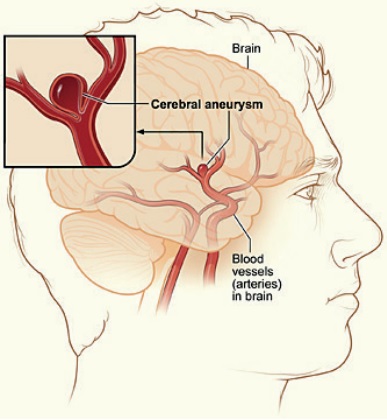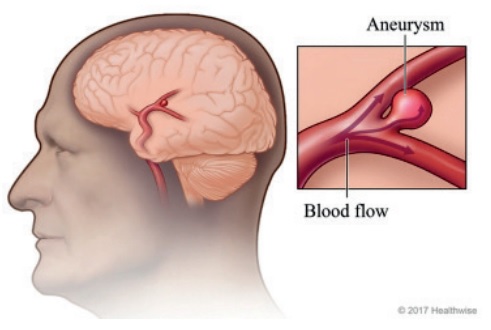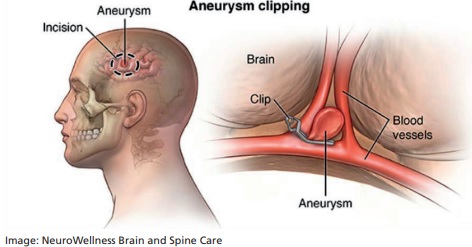Download and print as a PDF (568kB pdf)
On this page
- What is a brain aneurysm?
- What is a subarachnoid haemorrhage?
- What are the risk factors for a brain aneurysm?
- What is an incidental finding?
- How is a brain aneurysm diagnosed?
- What are the treatments for brain aneurysms?
- Can I prevent a brain aneurysm?
- Can I fly?
- Can I drive?
- Useful contacts
- Online information leaflets regarding treatmentof a brain aneurysm:
- Useful related websites
This leaflet is for patients, their families and carers to provide information about brain aneurysms, including incidental finding, risk factors for having an aneurysm, tests and investigations, and the treatment options and management of the condition.

What is a brain aneurysm?
A brain aneurysm (sometimes called a cerebral aneurysm) is a weakness in the wall of the blood vessel (artery) in the brain. This is a bulge which is similar to a balloon-like swelling on the artery. This balloon-like swelling may remain stable or may grow or rupture.

What is a subarachnoid haemorrhage?
A brain aneurysm can rupture with or without notice. This is called aneurysmal subarachnoid haemorrhage (SAH) where there is a bleeding into the fluid space surrounding the brain. It occurs if the bulge or weak area in a blood vessel (aneurysm) bursts or leaks. This is an uncommon type of stroke and it is a very serious condition that can lead to brain damage and can be fatal.
Most people with subarachnoid haemorrhage (SAH) have a sudden onset of headache and this headache is severe and unexpected as a clap of thunder (thunderclap headache).
Other symptoms are:
- Neck stiffness.
- Nausea.
- Vomiting.
- Sensitivity to light.
- Reduced consciousness.
- Confusion.
- Slurred speech and / or weakness on one side of the body.
- Fit (seizure).
However, these symptoms may vary from one person to another.
What are the risk factors for a brain aneurysm?
Factors that increase the risk for brain aneurysms and associated symptoms include:
- Hypertension (high blood pressure).
- Smoking.
- Excessive alcohol drinking or abuse.
- Illicit drug use, particularly cocaine.
- Age which is more common in people over the age of 40.
- Family history of brain aneurysms.
- Certain conditions such as polycystic kidney disease.
What is an incidental finding?
Some brain aneurysms are incidental findings and this is when an unruptured brain aneurysm may cause no symptoms (asymptomatic) and usually detected during CT scan or MRI imaging test performed for other medical conditions or unrelated symptoms.
These incidental findings of aneurysms are discussed in the Neurovascular Multi-disciplinary Meeting (MDT), then the outcome will be discussed with the patient in the Neurovascular clinic.
How is a brain aneurysm diagnosed?
- CT scan: another form of X-ray to take pictures of the brain from different angles.
- CT angiogram: this is a special type of CT scan that involves the use of dye (contrast). The dye is injected in to a vein in the arm and this helps to highlight blood vessels, making them more visible on the scan. The CTA scan can help to identify a SAH (Subarachnoid Haemorrhage) or an aneurysm that may not have seen on a standard CT scan.
- MRA scan (Magnetic Resonance Angiography): this is a procedure to give a good picture of the blood vessels and blood flow inside the body.
- MRI scan (Magnetic Resonance Imaging): this uses magnetic fields and radio waves to produce images of the internal structures of the body.
- DSA (Digital Subtraction Angiography): this is a procedure which involves inserting a small, thin tube / catheter into an artery in the groin or wrist and passing it up to the blood vessels in the brain.
What are the treatments for brain aneurysms?
Treatment options are influenced by your age, your general health, and the size and location of the aneurysm.
Some treatment is only carried out if the risk of rupture is particularly high.
Other people will have ongoing conservative management which means remaining under surveillance and repeating CT Scan or MRI / MRA scan at 12 or 24 month intervals to assess if the aneurysm has increased in size.
There are two treatment options for brain aneurysm which aim to prevent bleeding or re-bleeding:
Endovascular coiling (Embolisation)
This technique allows the aneurysm to be treated from the inside and is less invasive. This
is performed by an Interventional Neuro-Radiologist and carried out while you are asleep under general anaesthetic. You will be positioned on your back on the x-ray table. You will be given an intravenous (IV) fluid and your vital signs (heart rate, blood pressure, oxygen level, respiratory rate) and neurological signs will be monitored during and after the procedure.
A long thin tube (catheter) is inserted into your wrist or groin and will be navigated through the blood vessels while the x-ray machine collects images. Once the catheter reached the aneurysm, small detachable coils pack the aneurysm so it can no longer fill up with blood and coils remain inside the aneurysm permanently.

(Image source: The American Centre for Spine and Neurosurgery).
If the coiling was done for a ruptured aneurysm, you will be taken to HDU (High Dependency Unit) or ICU (Intensive Care Unit) for recovery and further observation.
If the coiling was done for unruptured aneurysm, you may stay in the hospital overnight to be monitored and an MRI / MRA will be performed before discharge.
You will remain flat in bed for 4 hours and a nurse will monitor your vital signs, neurological signs, the insertion site, and circulation or sensation in the affected leg. You may also be given a medication for pain or discomfort from the procedure.
You may also be advised to take Aspirin or Clopidogrel (Anti-platelet medications) for 3 months to prevent the formation of clot in the blood vessels.
You will be advised to avoid strenuous activities and your doctor will instruct you when you will be able to return to work and resume your normal activities.
Generally, you will have a follow-up MRI / MRA at 6 months, 24 months and / or at 5 years after the procedure to determine the coiling is working and you will be informed of the results once discussed in the Neurovascular Multi-Disciplinary Team (MDT) meeting.
Surgical clipping
The operation is carried out under general anaesthetic. The neurosurgeon removes a section of your skull to access the aneurysm and locates the blood vessel that feeds the aneurysm. Then the neurosurgeon places a tiny metal clip on the neck of the aneurysm to secure and stop the blood flow into it. The bone flap is then replaced and the scalp is stitched together. It will take about six months for your skull to heal.

The procedure will take a few hours and you will need to stay in HDU / ITU for a few days to be monitored. The incision may be sore for about 5 to 7 days after your surgery. It is common to have swelling and bruise to your face and you might also experience to have a difficulty opening your mouth fully because during a craniotomy, a small cut is made in the muscle that helps with chewing. You will be offered pain killers to help relieve discomforts.
You may also feel very tired for several weeks or months after surgery. You may also suffer with headache for a week or two. Overall, it will take 4 to 8 weeks to fully recover.
The Neurosurgeon and Neuroradiologist will discuss with you the risks and benefits of both procedures.
Coiling has generally been shown to have a lower risk of complications, such as seizures, than clipping in the short term and the long-term risks of further bleeding are low with both of these techniques.
Can I prevent a brain aneurysm?
Controlling blood pressure and stop smoking is strongly advised. Other measures are:
- Maintain normal blood pressure. Book an appointment with your GP if you suffer from high blood pressure.
- Stop Smoking or vaping as smoking is contributing factor to brain aneurysm. If you need support to stop smoking, book an appointment with your GP or please let us know.
- Avoid excessive alcohol intake.
- Avoid taking recreational drugs.
- Keep up a healthy diet and lifestyle. Ensure good quality of sleep and perform exercise regularly.
Can I fly?
You are safe to fly with untreated aneurysm but the decision is an individual one and it is best made after discussion with your doctor.
You are safe to fly depending on your recovery. The clips and coils will not affect you going through the airport security machines or scanners. You should keep yourself well hydrated during your travel.
It is an individual responsibility to inform the insurance company.
Can I drive?
You are legally obliged to notify the DVLA about your condition and must not drive until you have DVLA approval.
Useful contacts
Neurovascular Clinical Nurse Specialists (RSCH – Department of Neurosurgery)
Individual contacts:
Pita Villanueva – 07787 193371
Gillian Yalden – 07787 151520
Email
[email protected]
Phone
01273 696955
Ext. 67844
Online information leaflets regarding treatment
of a brain aneurysm:
- The National Institute for Health and Care Excellence
- Brain and Spine Foundation
- Brain and Spine Foundation Helpline. Run by nurses, providing support and information on all aspects of neurological conditions for patients, their families and carers and health professionals.
Useful related websites
- National Health Service (NHS)
- DVLA Drivers Medical Group
- NHS Free Smoking Helpline Phone: 0300 123 1044.
- Anxiety UK Helpline: 03444 775 774. Email: [email protected]
- Drinkline Helpline: 0300 123 1110 for free and confidential help.
This leaflet is intended for patients receiving care in Brighton & Hove or Haywards Heath.
The information in this leaflet is for guidance purposes only and is in no way
intended to replace professional clinical advice by a qualified practitioner.